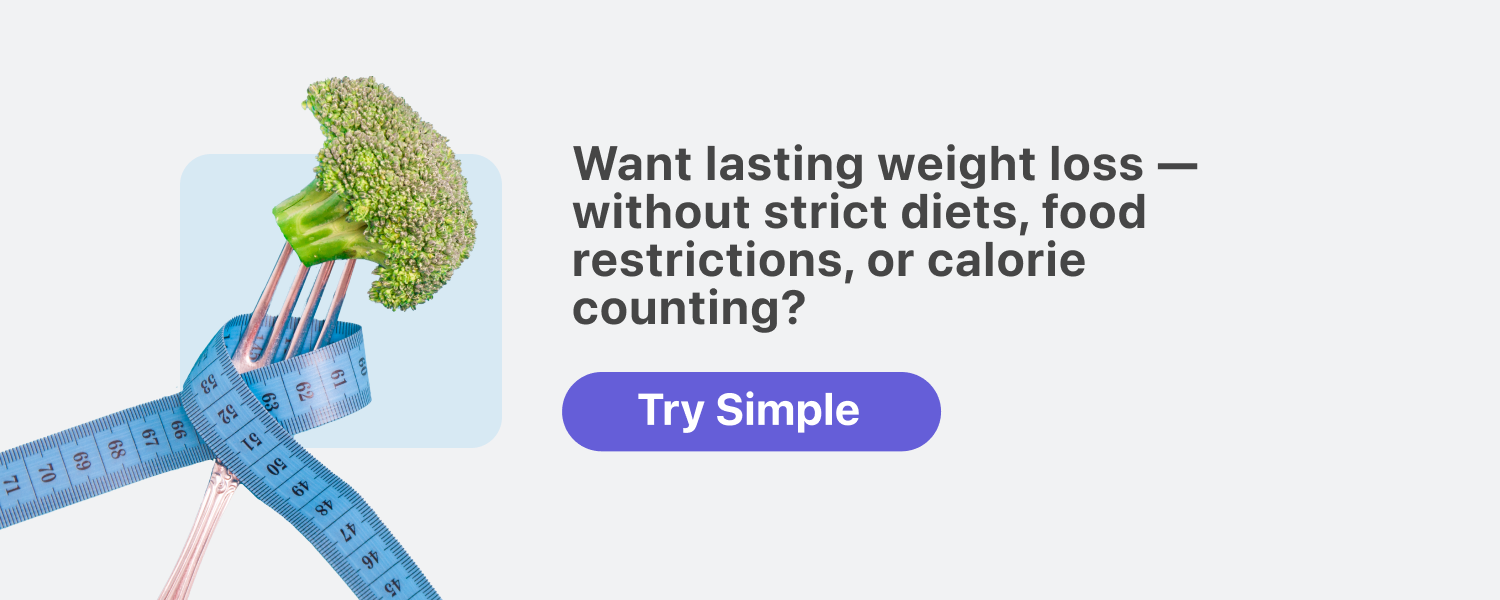Simple’s intermittent fasting picks according to belly type

We’ve all been there: that day when you put on your pants and … ouch.
The waistband is scrunching your stomach. The elastic isn’t elastic-ing quite enough. Or the belt holes seem to have suddenly shifted in the wrong direction.
Whatever the reason, you might have had at least one encounter with clothing waistbands that made you think: could I change my belly shape and size?

And, if you’ve been practicing (or interested in) intermittent fasting — alternating periods of eating with periods of abstaining from food — you might also have wondered: is there some kind of intermittent fasting that might be right for my belly type?
In this article, we’ll explore the question of whether intermittent fasting can help you to lose belly fat, particularly whether intermittent fasting according to belly type is even a thing.
Fancy trying intermittent fasting out? Take our Simple quiz, and we’ll give you a hand!
Best intermittent fasting schedules according to belly type
When it comes to intermittent fasting based on belly type, it can help to understand what affects your belly size and shape.
Each of us stores body fat, aka adipose tissue, in different places. Where exactly our body stores its fat depends on many factors,[4] including our:
- genetics [5,6]
- hormones
- age
- metabolism
- amount of body fat
So, although belly size and waist circumference can be influenced by intermittent fasting (because intermittent fasting can help folks lose body fat),[7] belly type is not as affected by intermittent fasting per se.
Fat isn’t just an inert pile of “stuff.” Rather, it’s a metabolically and hormonally active tissue that secretes all kinds of hormones and cell signaling molecules and helps our brain know how much stored energy we have available.
For good health, we want some body fat, but not too much — especially not too much in certain places.

Subcutaneous fat
Subcutaneous fat is the fat you can pinch.
It’s the stuff just under your skin that you can grab, that gives some folks those adorable cheek dimples or plush booties, and that pads the soles of our feet so we aren’t crunching our foot bones with every step.
We have subcutaneous fat all over our bodies. But where exactly it goes, again, depends on many factors. For instance, thanks to the effects of genetics, you probably put on subcutaneous fat like at least one of your close relatives does.
Women generally have more subcutaneous fat than men, particularly around the hips and thighs.[8] Age-related changes, hormonal fluctuations, and lifestyle factors such as diet and physical activity also impact its levels.
Folks who have more subcutaneous fat around their middle are more likely to be:[4]
- men and/or supplementing testosterone; or
- women who also have larger breasts and put on more fat in the upper body and face (and who might have a sister, mother, and/or aunt who’s shaped the same);
- women who have had at least one pregnancy; and/or
- women who have gone through menopause (so the hormonal environment has shifted).[9]
Thanks to the effects of estrogen, many women also put on more subcutaneous fat in their lower belly, rather than higher up, closer to their ribs.
In general, subcutaneous fat seems to be healthier than its cousin, visceral fat.[2,10]
Visceral fat
Visceral fat is fat around and within our viscera, or internal organs in our abdominal cavity.
While we need some visceral fat to cushion our organs (we don’t want them smashing around in there while we’re running and jumping, for instance), too much can be a problem.[2]
Visceral fat can infiltrate (or deposit itself) into internal organs like our heart, kidneys, and liver and affect their function.
Unfortunately, this type of fat can significantly disrupt the health of those organs as well as our general metabolic health and increase our risk of diseases like type 2 diabetes, cardiovascular disease, and/or chronic kidney disease.[11,12,13]
Folks who have more visceral fat are more likely to:
- be older;
- be highly stressed (because chronic stress releases cortisol, which can contribute to fat deposits around the midsection);
- be less physically active;
- have more body fat in general; and/or
- be of South or East Asian descent.[6,14]
Belly bloating
This isn’t belly fat — it’s belly distention. You might feel “stuffed,” or feel pressure in your abdomen. Maybe your belly even feels hard to the touch. You might notice you start the day feeling normal and end the day feeling like an over-inflated balloon.
This can occur for many reasons, such as:[15]
- a food intolerance that causes intestinal gas (so your “belly type” might actually be, for instance, “lactose belly” or “can’t digest broccoli belly”)
- slow digestion that means food stays in your gastrointestinal tract longer
- constipation
- fluid retention during your menstrual cycle or with perimenopause
If this is a persistent problem beyond a day or two of “Oof, I shouldn’t have eaten that high-fiber double-sauerkraut triple-cheese bean casserole and washed it down with extra-fizzy soda,” consult your doctor for guidance.
OK, so what’s the best method of intermittent fasting based on belly type?

Just like there are different belly types, there are many different types of intermittent fasting, each with its own pros and cons.
At Simple, the approach we recommend most is time-restricted eating, or TRE. With this method, you fast for several hours, most likely overnight, then enjoy an “eating window” of normal eating.
There are many types of TRE schedules, such as:
- 12:12 (12 hours fasting + 12 hours eating)
- 14:10 (14 hours fasting + 10 hours eating)
- 16:8 (16 hours fasting + 8 hours eating)
The flexibility of TRE makes it an ideal approach for all body types. So, should you be “fasting according to belly type”? Not really, since all types of belly fat will change with intermittent fasting.
While research definitely suggests that time-restricted eating can help people lose visceral fat, it can also help us lose other fat too.[16]
Let’s explore further.
How does intermittent fasting affect belly fat?
Fasting involves a period of several hours without food. Somewhere around 8–12 hours after our last meal, our body runs out of fuel from that meal and needs to use fuel that we’ve stored, i.e., our body fat. This is the fasted state.
Luckily, most of us have some fat to burn, including belly fat. (Check your Simple app during your fasting periods to see your fat-burning status change in real time!)
Is intermittent fasting a good method for burning belly fat?
Research suggests that visceral fat may be more sensitive to fasting — in other words, our body might burn deep abdominal belly fat first during fasting periods when our last meal runs out.[17]
However, other evidence suggests that all belly fat types can be reduced with intermittent fasting. For instance, one study found that after 12 weeks of intermittent fasting, people with prediabetes had lost:[18]
- subcutaneous fat;
- visceral fat;
- liver fat; and
- fat in the pancreas (where insulin is produced).
All of these changes are linked to health benefits, so it’s a win all around.

What factors impact your ability to lose belly fat?
There are some other key factors that can affect your ability to lose belly fat.
Nutrition
In general, if we eat too much energy (aka too many calories), we’ll gain weight. Conversely, if we eat fewer calories than we burn, we’ll lose weight.
So, while intermittent fasting allows you to eat a flexible diet, if your goal is weight loss, then double-check how many calories you’re consuming. (Try logging your food in your Simple app for personalized nutrition insights and recommendations. Start by taking our Simple quiz, and you’ll master your nutrition game in no time!)
While one common intermittent fasting side effect is being hungry, you’ll find yourself less hungry if you include more protein, fruits, vegetables, and fiber in your diet — which means you’ll eat less but feel more satisfied.
For instance, one study found that intermittent fasting combined with a higher-protein diet (with protein at most meals) led to more fat loss than calorie restriction (aka a standard “diet”).[19]
On the flip side, look for ways to eat fewer highly processed foods (think: pastries, candy, packaged snack foods, sugar-sweetened drinks, and so on). Some evidence suggests that consuming a lot of fructose — a type of sweetener used in many processed foods and drinks like soda — can contribute to belly fat.[20]
Sleep
Sleep and visceral fat have a bidirectional relationship. In other words, having more visceral fat can make your sleep worse, and sleeping worse can increase your chances of having more visceral fat.[21,22,23]
However, this can also work in a positive direction: improving your sleep will often help you lose belly fat more easily … and losing belly fat can also improve your sleep.
For many people, this may mean a trip to your doctor to be evaluated for sleep issues, such as sleep apnea.
Stress
Chronic stress may add to our belly fat woes. Cortisol, one of our key stress hormones, can increase fat deposits around our middle.[24] (Not to mention the fact that many of us eat when we’re stressed!)
It may seem counterintuitive, but tackling your stress with activities like meditation or time in nature may actually help you lose belly fat as well.
Exercise and physical activity
It shouldn’t be a shock that being physically active helps manage belly fat, so let’s look more closely at that.
Is exercise necessary when intermittent fasting to lose belly fat?

Strictly speaking, you don’t need to exercise to lose belly fat. However, it works much better when you do.
For instance, one study compared groups who were restricting calories and either doing aerobic exercise, resistance training (e.g., lifting weights), or a combination of everything.[25]
Researchers found that the combination of both eating less and exercising in different ways was the most effective. People doing the combination lost more visceral fat (aka belly fat) compared to those in the aerobic- or resistance-only groups.
Bonus: The combination group also enjoyed the most improvements in insulin sensitivity, physical function, aerobic capacity, gait speed, and knee strength. In other words, wins all around.
Benefits of exercising while intermittent fasting
Combining exercise with intermittent fasting (and good nutrition, of course) is one of the best ways to lose belly fat.
You can exercise while you’re actually fasting — i.e., during your fasting window — as well as during your eating window.
- During the fasting window, it’s generally better to do “low and slow,” such as walking, easy hiking, or leisurely bike riding or swimming. Here, you’re almost exclusively using body fat for fuel, so this will chip away at that belly fat nice and easy.
- Save the more intense exercise, such as hardcore hikes, CrossFit, or fast-paced runs, for your eating window after you’ve had at least one meal. While you’re not using primarily fat during intense exercise, you are able to work harder — which means more calories burned and more belly fat lost in the long run.
Exercise helps us regulate insulin and blood sugar better, clears the fatty acids out of our liver, and helps our body more effectively use stored body fat for fuel from other places like our muscles (aka intramuscular triglyceride).[26]
Building muscle mass — a key benefit of exercise, especially resistance training — helps improve our metabolic health as well as our everyday function (think: going up and down stairs, carrying groceries, etc.).[27]
Some evidence suggests that TRE combined with exercise may even improve VO2 max (aka our body’s ability to take in and use oxygen).[28] In turn, this might make workouts a little easier — which often helps us feel more motivated to do more.
Drawbacks of exercising while intermittent fasting
Some people might find they have less energy in their fasting window. No problem — take a look at your schedule and figure out when it might be best for you to exercise during your eating window.
If you’re doing intense athletic training, make sure to eat before and after a hard workout to provide enough fuel in the tank, as well as nutrients for recovery afterward.
Check out this article for more on intermittent fasting and working out.
4 tips on choosing the best intermittent fasting schedule for your belly type

1. Check with your doctor about your overall health and risk.
Your belly size and type — along with your genetics / ethnicity, age, body composition (ratio of lean mass to body fat), and other medical conditions will shape your overall health situation.
So, consult with your healthcare provider to find out what the best path might be for you — as well as what type of intermittent fasting might be a fit for your unique situation.
2. Look for the schedule that keeps your stress low.
Since stress is a factor in belly fat, find an intermittent fasting approach that’s as easy as possible for you to follow — especially if you’re an intermittent fasting beginner.
Two of the most common intermittent fasting mistakes are either going too hard, too fast, too soon, or being too strict with oneself about sticking to an intermittent fasting schedule.
Transition to your intermittent fasting lifestyle gradually, looking for a schedule that aligns with your needs and preferences.
3. Go for the combo.
Good health behaviors work together. You’re more likely to lose body fat by combining fasting with nutrition, exercise, sleep, and stress management.
So, along with whatever intermittent fasting schedule you choose, also look for ways you can improve your other health and lifestyle choices.
4. Try a slightly longer fast.
Start with something easy-ish, like a 12-hour fast (and make sure to put your sleep time in the middle of that … that’s 8 hours out of the way right there!). As you get more comfortable, try fasting a little longer, like 14 or 16 hours. Research suggests that the longer the fast, the more weight you’re likely to lose.[29]
We don’t, however, recommend fasting beyond 18 hours as there is no evidence to show any additional benefits. So remember to keep it below 18 hours; that’s the sweet spot!
Frequently asked questions about intermittent fasting and belly type
Intermittent fasting can reduce belly fat by promoting weight loss overall.[30] Belly fat might be more stubborn due to genetic, hormonal, or lifestyle factors, as we covered earlier on. Consistent fasting, coupled with a balanced diet and exercise, generally aids in reducing overall body fat, including the abdominal area.
Yes and no. Our general shape — for example, where we tend to gain or lose fat, or how long our limbs are, etc. — is largely determined by our genetics and hormones.
But, when we lose body fat or gain muscle, especially if we’re consistent with healthy nutrition and exercise, we can change our shape significantly by becoming leaner and/or more muscular.
Run through a quick checklist:
- Nutrition: Am I eating the right types of foods and the right amount of calories?
- Exercise and physical activity: Am I regularly active, doing a mix of exercise?
- Sleep: Am I getting enough quality sleep?
- Stress: How much stress do I have in my life, and how well am I managing it?
Ask our friendly assistant Avo for help with any of these topics, and check with your healthcare provider if you think that you might have any underlying medical conditions.
Spin the roulette wheel — it’s totally random! Your unique body will make its decision about where to lose fat based mainly on your genetics, hormones, and age.
You can’t control where exactly you lose fat from first, so just place your bets and enjoy the experience!
Somewhere around 8–12 hours after your last meal, you start to burn mainly stored body fat for fuel.[31]
This will deplete stored glycogen (carbohydrate-based fuel) in your liver and muscles, requiring your body to turn to stored body fat earlier. You can speed this up by having a lower-carbohydrate meal as your last meal and by doing some light to moderate exercise afterward. Ready to optimize your fasting journey? Get started today by taking the Simple quiz!

- Emery EM, Schmid TL, Kahn HS, Filozof PP. A review of the association between abdominal fat distribution, health outcome measures, and modifiable risk factors. Am J Health Promot. 1993 May-Jun;7(5):342–53.
- Jayedi A, Khan TA, Aune D, Emadi A, Shab-Bidar S. Body fat and risk of all-cause mortality: a systematic review and dose-response meta-analysis of prospective cohort studies. Int J Obes . 2022 Sep;46(9):1573–81.
- Chen W, Liu X, Bao L, Yang P, Zhou H. Health effects of the time-restricted eating in adults with obesity: A systematic review and meta-analysis. Front Nutr. 2023 Feb 16;10:1079250.
- Frank AP, de Souza Santos R, Palmer BF, Clegg DJ. Determinants of body fat distribution in humans may provide insight about obesity-related health risks. J Lipid Res. 2019 Oct;60(10):1710–9.
- Agrawal S, Wang M, Klarqvist MDR, Smith K, Shin J, Dashti H, et al. Inherited basis of visceral, abdominal subcutaneous and gluteofemoral fat depots. Nat Commun. 2022 Jun 30;13(1):3771.
- Sun C, Kovacs P, Guiu-Jurado E. Genetics of Body Fat Distribution: Comparative Analyses in Populations with European, Asian and African Ancestries. Genes [Internet]. 2021 May 29;12(6).
- Sun JC, Tan ZT, He CJ, Hu HL, Zhai CL, Qian G. Time-restricted eating with calorie restriction on weight loss and cardiometabolic risk: a systematic review and meta-analysis. Eur J Clin Nutr. 2023 Nov;77(11):1014–25.
- Karastergiou K, Smith SR, Greenberg AS, Fried SK. Sex differences in human adipose tissues – the biology of pear shape. Biol Sex Differ. 2012 May 31;3(1):13.
- Ko SH, Jung Y. Energy Metabolism Changes and Dysregulated Lipid Metabolism in Postmenopausal Women. Nutrients [Internet]. 2021 Dec 20;13(12).
- Jayedi A, Soltani S, Zargar MS, Khan TA, Shab-Bidar S. Central fatness and risk of all cause mortality: systematic review and dose-response meta-analysis of 72 prospective cohort studies. BMJ. 2020 Sep 23;370:m3324.
- Neeland IJ, Ross R, Després JP, Matsuzawa Y, Yamashita S, Shai I, et al. Visceral and ectopic fat, atherosclerosis, and cardiometabolic disease: a position statement. Lancet Diabetes Endocrinol. 2019 Sep;7(9):715–25.
- Kataoka H, Nitta K, Hoshino J. Visceral fat and attribute-based medicine in chronic kidney disease. Front Endocrinol. 2023 Feb 9;14:1097596.
- Gugliucci A. Biomarkers of dysfunctional visceral fat. Adv Clin Chem. 2022 Jul 13;109:1–30.
- Williams R, Periasamy M. Genetic and Environmental Factors Contributing to Visceral Adiposity in Asian Populations. Endocrinol Metab (Seoul). 2020 Dec;35(4):681–95.
- Seo AY, Kim N, Oh DH. Abdominal bloating: pathophysiology and treatment. J Neurogastroenterol Motil. 2013 Oct;19(4):433–53.
- He M, Wang J, Liang Q, Li M, Guo H, Wang Y, et al. Time-restricted eating with or without low-carbohydrate diet reduces visceral fat and improves metabolic syndrome: A randomized trial. Cell Rep Med. 2022 Oct 18;3(10):100777.
- Harney DJ, Cielesh M, Chu R, Cooke KC, James DE, Stöckli J, et al. Proteomics analysis of adipose depots after intermittent fasting reveals visceral fat preservation mechanisms. Cell Rep. 2021 Mar 2;34(9):108804.
- Dokpuang D, Zhiyong Yang J, Nemati R, He K, Plank LD, Murphy R, et al. Magnetic resonance study of visceral, subcutaneous, liver and pancreas fat changes after 12 weeks intermittent fasting in obese participants with prediabetes. Diabetes Res Clin Pract. 2023 Aug;202:110775.
- Arciero PJ, Poe M, Mohr AE, Ives SJ, Arciero A, Sweazea KL, et al. Intermittent fasting and protein pacing are superior to caloric restriction for weight and visceral fat loss. Obesity . 2023 Feb;31 Suppl 1(Suppl 1):139–49.
- DiNicolantonio JJ, Mehta V, Onkaramurthy N, O’Keefe JH. Fructose-induced inflammation and increased cortisol: A new mechanism for how sugar induces visceral adiposity. Prog Cardiovasc Dis. 2018 May-Jun;61(1):3–9.
- Vgontzas AN, Bixler EO, Chrousos GP. Metabolic disturbances in obesity versus sleep apnoea: the importance of visceral obesity and insulin resistance. J Intern Med. 2003 Jul;254(1):32–44.
- Trakada G, Chrousos G, Pejovic S, Vgontzas A. Sleep Apnea and its association with the Stress System, Inflammation, Insulin Resistance and Visceral Obesity. Sleep Med Clin. 2007 Jun;2(2):251–61.
- Ryan S, Arnaud C, Fitzpatrick SF, Gaucher J, Tamisier R, Pépin JL. Adipose tissue as a key player in obstructive sleep apnoea. Eur Respir Rev [Internet]. 2019 Jun 30;28(152).
- Thau L, Gandhi J, Sharma S. Physiology, Cortisol. StatPearls Publishing; 2022.
- Waters DL, Aguirre L, Gurney B, Sinacore DR, Fowler K, Gregori G, et al. Effect of Aerobic or Resistance Exercise, or Both, on Intermuscular and Visceral Fat and Physical and Metabolic Function in Older Adults With Obesity While Dieting. J Gerontol A Biol Sci Med Sci. 2022 Jan 7;77(1):131–9.
- Stokie JR, Abbott G, Howlett KF, Hamilton DL, Shaw CS. Intramuscular lipid utilization during exercise: a systematic review, meta-analysis, and meta-regression. J Appl Physiol. 2023 Mar 1;134(3):581–92.
- Keenan S, Cooke MB, Belski R. The Effects of Intermittent Fasting Combined with Resistance Training on Lean Body Mass: A Systematic Review of Human Studies. Nutrients [Internet]. 2020 Aug 6;12(8).
- Correia JM, Santos I, Pezarat-Correia P, Minderico C, Mendonca GV. Effects of Intermittent Fasting on Specific Exercise Performance Outcomes: A Systematic Review Including Meta-Analysis. Nutrients [Internet]. 2020 May 12;12(5).
- Welton S, Minty R, O’Driscoll T, Willms H, Poirier D, Madden S, et al. Intermittent fasting and weight loss: Systematic review. Can Fam Physician. 2020 Feb;66(2):117–25.
- Vasim I, Majeed CN, DeBoer MD. Intermittent Fasting and Metabolic Health. Nutrients [Internet]. 2022 Jan 31;14(3).
- Anton SD, Moehl K, Donahoo WT, Marosi K, Lee SA, Mainous AG 3rd, et al. Flipping the Metabolic Switch: Understanding and Applying the Health Benefits of Fasting. Obesity . 2018 Feb;26(2):254–68.
